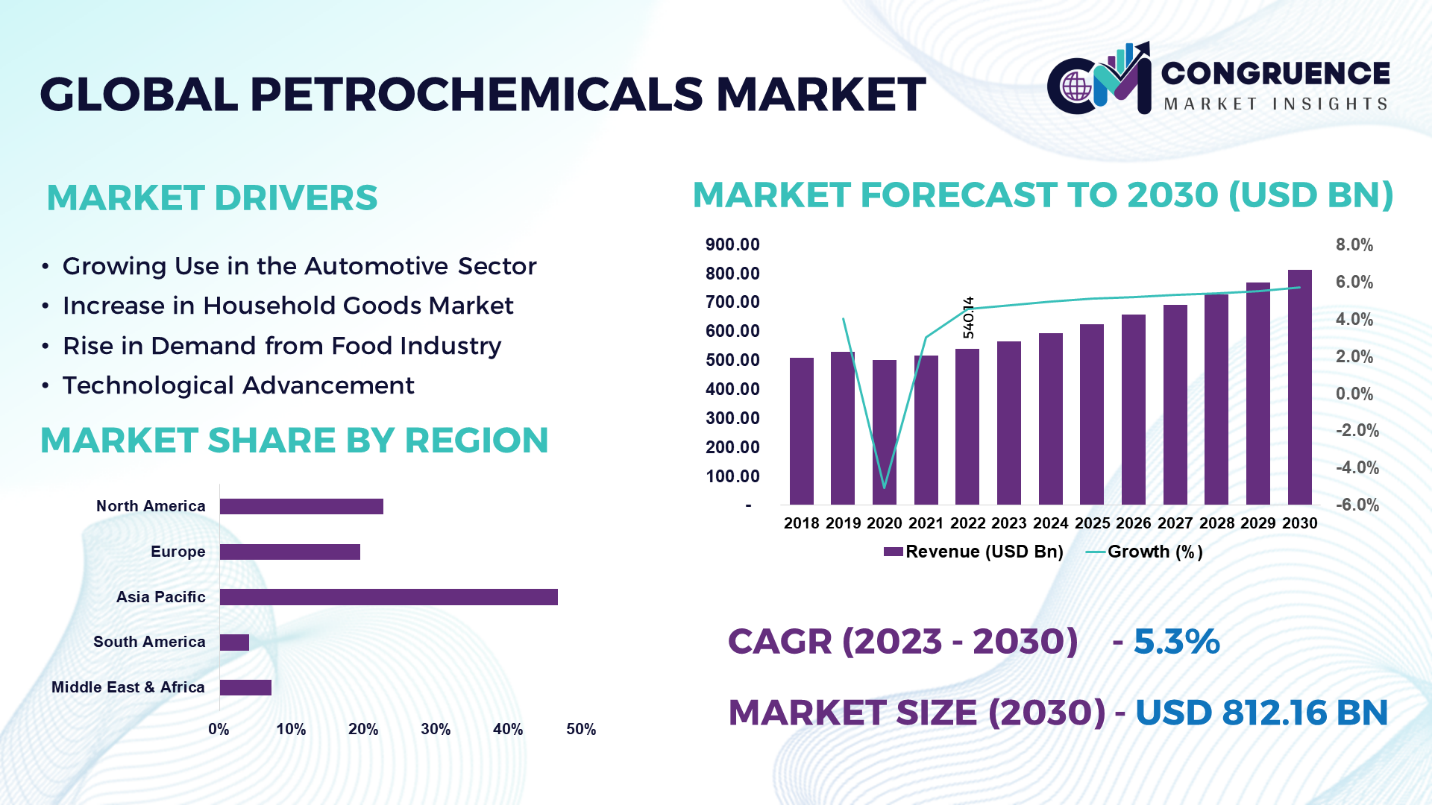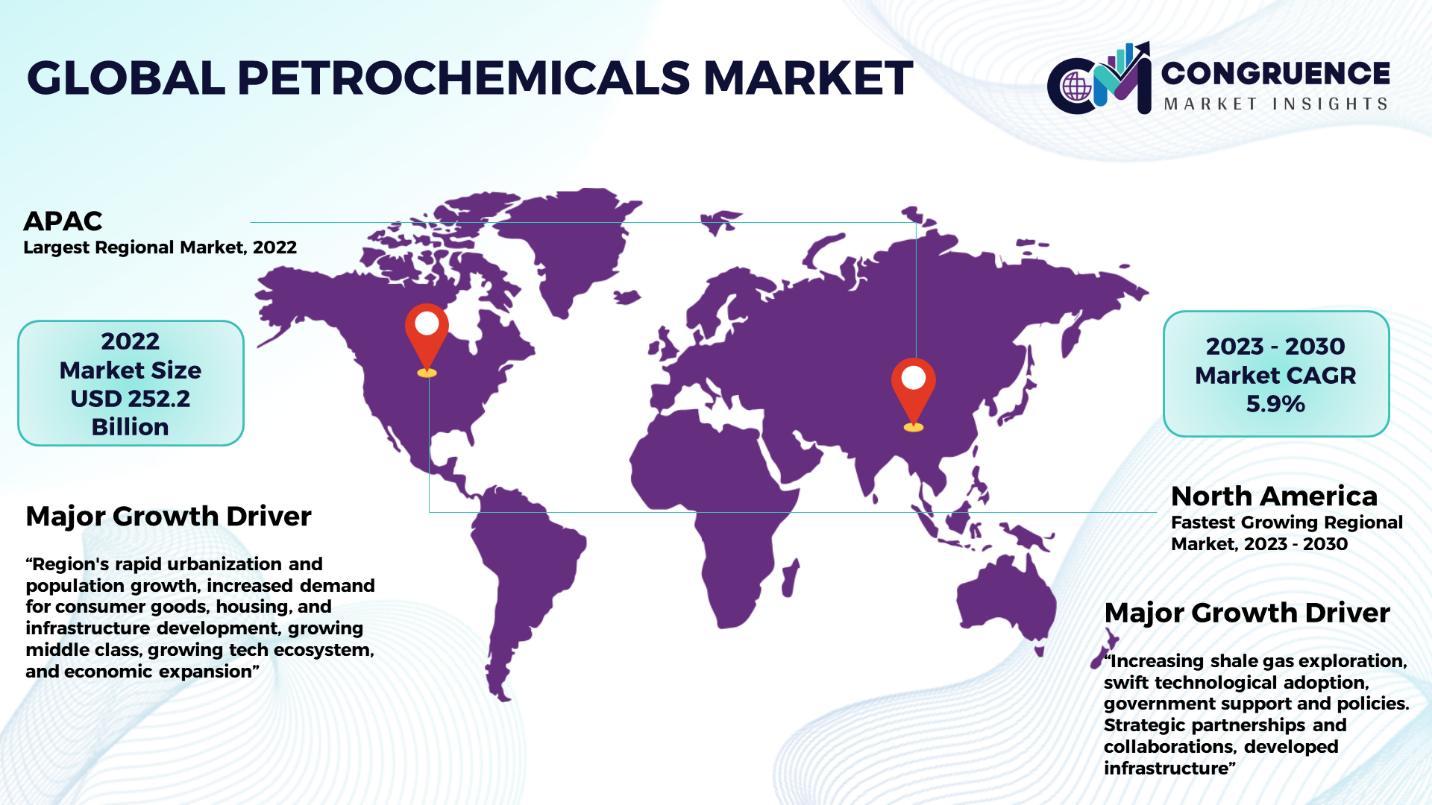Reports
The Global Petrochemicals Market was valued at USD 540.14 Billion in 2022 and is anticipated to reach a value of USD 812.16 Billion by 2030 expanding at a CAGR of 5.3% between 2023 and 2030.
Petrochemicals are the chemical products that are generated from petroleum through refining, they are commonly shortened to petchems. Certain chemical compounds derived from petroleum can also be found in renewable sources such as sugar cane, maize, and palm fruit, as well as other fossil fuels including coal and natural gas. Olefins, which include ethylene and propylene, and aromatics, which include benzene, toluene, and isomers of xylene, are the two most prevalent petrochemical classes. Petroleum fractions are cracked by fluid catalysis in oil refineries to create aromatics and olefins. Olefins are produced at chemical facilities through the steam cracking of natural gas liquids, such as propane and ethane. Naphtha undergoes catalytic reformation to create aromatics. The building blocks of many different substances, including adhesives, detergents, and solvents, are olefins and aromatics. Polymers and oligomers that are utilized in plastics, resins, fibers, elastomers, lubricants, and gels are derived from olefins. The foundation of an industrial economy, petrochemicals are a vital component of numerous industrial procedures. Petrochemical detergents are the source of thousands of items, such as tires, industrial oil, and plastic (the product's basic form, which serves as an ingredient in the creation of consumer goods). Products derived from petroleum are utilized in building materials, automobiles, paints, medical equipment, packaging, and home and apparel items. These are a few typical uses. Furthermore, the business is coming up with new technological innovations and improving its capacity to process various kinds of raw materials.

Petrochemicals Market Major Driving Forces
Growing Use in the Automotive Sector: owing to petrochemicals' various qualities, including their light weight, flexibility, durability, and design, the automobile sector makes extensive use of them. Petrochemical intermediates are used to make the dashboard, tires, body, and interior components. The greater usage of composite materials based on petrochemicals in automotive manufacture has transformed the sector and helped to expand the market.
Increase in Household Goods Market: Most home items, including makeup, fragrances, cosmetics, and aftershaves, are made from petrochemical materials. Petrochemical compounds are also present in significant amounts in shampoos and hair dyes. Petroleum derivatives are used to make beard and hair wax, which is anticipated to propel the petrochemical industry's expansion.
Rise in Demand from Food Industry: The food business uses a variety of petrochemical chemicals to create preservatives. Foods kept in bags and cans have longer shelf lives due to these ingredients. Certain substances are also included in candy and food coloring. To enhance taste and flavor, other petrochemical compounds are also used in their production.
Technological Advancement: Technological and process developments in the petrochemical sector lead to higher productivity, lower costs, and the creation of new goods, all of which propel the market's expansion.
Petrochemicals Market Key Opportunities
Expanding Consumer Demand in Developing Nations: The need for petrochemicals is being driven by the fast industrialization, urbanization, and rise of the middle class in developing nations, especially in Asia. In order to supply the demand for plastics, synthetic fibers, and other products derived from petrochemicals, these growing markets present substantial growth prospects for petrochemical producers.
Move Toward Bio-Based and Sustainable Substitutes: The development and commercialization of bio-based and renewable feedstocks by the petrochemical industry is made possible by the growing focus on sustainability and the circular economy. Investigating substitutes such as bio-based polymers, biodegradable materials, and recycling technologies are some examples of this. Companies can meet changing consumer tastes and maintain their competitiveness by allocating resources towards research and development of sustainable alternatives.
Data Analytics and Digitalization: In the petrochemicals industry, utilizing digital technologies—such as artificial intelligence and data analytics—can improve supply chain management, streamline operations, and offer insightful information for decision-making.
Petrochemicals Market Key Trends
· The petrochemicals business has seen a transition toward sustainable methods due to growing public awareness of environmental issues.
· Increasing interest in bio-based feedstocks as fossil fuel substitutes.
· The petrochemicals sector is changing due to digitalization, which includes automation, artificial intelligence, and data analytics.
· Growing need for speciality compounds with unusual characteristics.
· Manufacturing of high-value petrochemical goods to boost profitability, such as specialized chemicals and sophisticated polymers.
· Novel technologies are being created to improve plastics' capacity to be recycled.
· The movement toward electrification is having an impact on the creation of novel materials and chemicals, particularly in the automobile sector.
Region-wise Market Insights
Asia-Pacific accounted for the largest market share at 46.7% in 2022 whereas, North America is expected to register the fastest growth, expanding at a CAGR of 5.9% between 2023 and 2030.

The Asia-Pacific area is experiencing significant expansion in a number of areas, including industrial activity and investment. This growth is mostly attributable to the region's rapid urbanization and population growth, which have increased demand for consumer goods, housing, and infrastructure development. In addition, the growing middle class in the area is stimulating consumerism and creating a robust market for goods and services from a variety of businesses. Asia Pacific also gains from a growing tech ecosystem, as nations including China and India become global tech hubs that draw investment and promote innovation. Economic expansion is also being aided by trade agreements, foreign direct investment, and supportive government policies. As a result of its advantageous geographic location, the region is positioned to play a significant role in international trade and to gain from its expansion. North America is predicted to become the area with the fastest rate of growth in the global petrochemicals market due to the increasing shale gas exploration operations in the United States and Canada. These nations' increasing shale gas production offers the chance to use shale gas instead of conventional feedstock to produce a range of petrochemicals. Over the projection period, significant capacity additions are anticipated to drive growth in the United States and Canada.
Market Competition Landscape
The worldwide petrochemicals market is highly competitive, with major industry players competing with one another for market share and profitability. Market players use a variety of tactics to obtain a competitive advantage. These tactics include investments in cutting-edge technologies to increase manufacturing efficiency as well as ongoing R&D initiatives to create and produce new, high-value items. To lessen dependency on certain market segments, companies also concentrate on diversifying their product portfolios to appeal to a wide range of industries and end-users. Furthermore, companies continue to prioritize cost optimization as a crucial component in their efforts to optimize operations and minimize production expenses. Sustainability efforts, such as developing environmentally friendly substitutes and adhering to strict environmental laws, are playing a more and bigger role in determining competitiveness. Moreover, enhancing market reach and competencies is largely dependent on strategic alliances and mergers & acquisitions. Prominent players in the market include:
· BASF SE
· Lyondell Basell Industries Holdings B.V.
· INEOS
· Shell Plc.
· SABIC
· Reliance Industries Limited
· Mitsubishi Chemical Holdings Corporation
· Dow
· LG Chem
· Chevron Phillips Chemical Company LLC.
· China National Petroleum Corporation
· Maruzen Petrochemical
· SIBUR Holding PJSC
· Unicorn Petroleum
|
Report Attribute/Metric |
Details |
|
Market Revenue in 2022 |
USD 540.14 Billion |
|
Market Revenue in 2030 |
USD 812.16 Billion |
|
CAGR (2023 – 2030) |
5.3% |
|
Base Year |
2022 |
|
Forecast Period |
2023 – 2030 |
|
Historical Data |
2018 to 2022 |
|
Forecast Unit |
Value (US$ Mn) |
|
Key Report Deliverable |
Revenue Forecast, Growth Trends, Market Dynamics, Segmental Overview, Regional and Country-wise Analysis, Competition Landscape |
|
Segments Covered |
· By Product (Ethylene, Propylene, Butadiene, Benzene, Xylene, Toluene, Polystyrene, Methanol) · By Manufacturing Process (Fluid Catalytic Cracking (FCC), Steam Cracking, Catalytic Reforming) · By Application (Polymers, Paints and Coatings, Solvents, Rubber, Adhesives and Sealants, Surfactants, Dyes, Others) · By End-Use Industry (Packaging, Automotive and Transportation, Construction, Electrical and Electronics, Healthcare, Others) |
|
Geographies Covered |
North America: U.S., Canada and Mexico Europe: Germany, France, U.K., Italy, Spain, and Rest of Europe Asia Pacific: China, India, Japan, South Korea, Southeast Asia, and Rest of Asia Pacific South America: Brazil, Argentina, and Rest of Latin America Middle East & Africa: GCC Countries, South Africa, and Rest of Middle East & Africa |
|
Key Players Analyzed |
BASF SE, LyondellBasell Industries Holdings B.V., INEOS, Shell Plc., SABIC, Reliance Industries Limited, Mitsubishi Chemical Holdings Corporation, Dow, LG Chem, Chevron Phillips Chemical Company LLC., China National Petroleum Corporation, Maruzen Petrochemical, SIBUR Holding PJSC, Unicorn Petroleum |
|
Customization & Pricing |
Available on Request (10% Customization is Free) |
